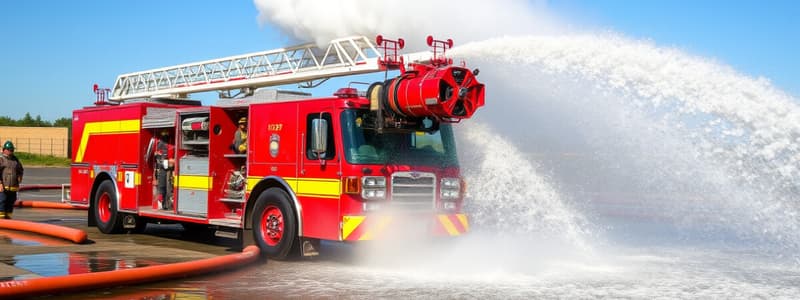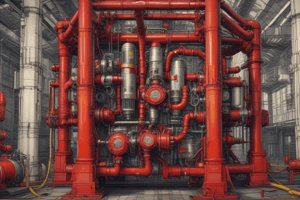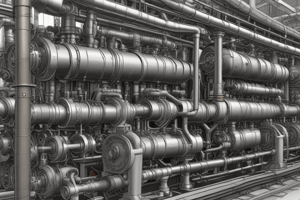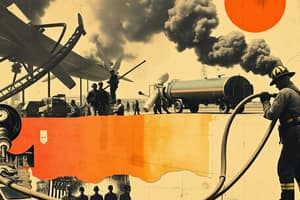Podcast
Questions and Answers
What is the minimum depth of water required over a traditional strainer for a pumper to reach its rated capacity?
What is the minimum depth of water required over a traditional strainer for a pumper to reach its rated capacity?
- 20 inches (500 mm)
- 24 inches (600 mm) (correct)
- 22 inches (550 mm)
- 26 inches (650 mm)
Which of the following is a potential risk of using a traditional strainer with less than the required depth of water?
Which of the following is a potential risk of using a traditional strainer with less than the required depth of water?
- Increased noise levels
- Insufficient water flow
- Clogging with foreign objects (correct)
- Decreased pump efficiency
What method can be used to increase the depth of water when drafting from a shallow stream?
What method can be used to increase the depth of water when drafting from a shallow stream?
- Use a larger strainer
- Increase the pump's flow rate
- Use a smaller hose
- Construct a dam (correct)
Why is a floating strainer advantageous in drafting operations?
Why is a floating strainer advantageous in drafting operations?
What issue can occur if debris enters the intake hose during drafting?
What issue can occur if debris enters the intake hose during drafting?
What should be done to minimize the chances of a whirlpool forming around a traditional strainer?
What should be done to minimize the chances of a whirlpool forming around a traditional strainer?
What is a disadvantage of a floating strainer?
What is a disadvantage of a floating strainer?
Which environmental condition could limit the effectiveness of a water source for firefighting?
Which environmental condition could limit the effectiveness of a water source for firefighting?
What effect does increasing elevation pressure have on the ability to draft water?
What effect does increasing elevation pressure have on the ability to draft water?
Which statement is true about the capacity of pumps meeting NFPA® standards?
Which statement is true about the capacity of pumps meeting NFPA® standards?
What is a recommended practice when selecting a drafting site for effective water supply?
What is a recommended practice when selecting a drafting site for effective water supply?
What happens to the pump's capacity when the lift height exceeds the recommended maximum?
What happens to the pump's capacity when the lift height exceeds the recommended maximum?
What preliminary action should be taken before engaging the pump?
What preliminary action should be taken before engaging the pump?
What is the atmospheric pressure at sea level in psi?
What is the atmospheric pressure at sea level in psi?
Which factor does NOT affect friction loss in the intake hose?
Which factor does NOT affect friction loss in the intake hose?
A pumper with a 5-inch intake hose can increase the capacity to which of the following?
A pumper with a 5-inch intake hose can increase the capacity to which of the following?
When drafting water, what is the purpose of creating a pressure differential in the pump?
When drafting water, what is the purpose of creating a pressure differential in the pump?
If the atmospheric pressure decreases by 0.5 psi, how much does it equate to in inches of mercury?
If the atmospheric pressure decreases by 0.5 psi, how much does it equate to in inches of mercury?
What happens to the total pump capacity when the lift height increases?
What happens to the total pump capacity when the lift height increases?
What is the primary function of a low-level strainer when drafting from a portable tank or swimming pool?
What is the primary function of a low-level strainer when drafting from a portable tank or swimming pool?
What vacuum measurement indicates a pressure of -2 psi?
What vacuum measurement indicates a pressure of -2 psi?
Why must tidal conditions be monitored during drafting operations?
Why must tidal conditions be monitored during drafting operations?
What is the pressure at 5,000 feet above sea level?
What is the pressure at 5,000 feet above sea level?
What water temperature range is considered critical for pump operation?
What water temperature range is considered critical for pump operation?
Which of the following statements about friction loss is true?
Which of the following statements about friction loss is true?
What should be done after pumping nonpotable water through the apparatus?
What should be done after pumping nonpotable water through the apparatus?
An intake hose designed for 750 gpm is generally which diameter?
An intake hose designed for 750 gpm is generally which diameter?
What impact can dirty or sandy water have on the pump?
What impact can dirty or sandy water have on the pump?
Which type of water may cause corrosion in the pump?
Which type of water may cause corrosion in the pump?
What is the consequence of not addressing dirty water at a drafting site?
What is the consequence of not addressing dirty water at a drafting site?
What is essential for the operation of a pump during high-tide conditions?
What is essential for the operation of a pump during high-tide conditions?
What is the primary purpose of inspecting the gaskets before operating a fire pump?
What is the primary purpose of inspecting the gaskets before operating a fire pump?
When connecting the intake hose to the strainer, what is one recommended method to simplify the process?
When connecting the intake hose to the strainer, what is one recommended method to simplify the process?
Which factor should be considered when positioning the fire pump vehicle during drafting?
Which factor should be considered when positioning the fire pump vehicle during drafting?
What might occur if there is dirt or gravel inside the coupling during the connection of the intake hose?
What might occur if there is dirt or gravel inside the coupling during the connection of the intake hose?
What is a critical step to ensure an airtight connection between couplings in a fire pump setup?
What is a critical step to ensure an airtight connection between couplings in a fire pump setup?
What is a primary function of the primer in this context?
What is a primary function of the primer in this context?
Why should the pump fill not be hindered during operation?
Why should the pump fill not be hindered during operation?
What might be a consequence of having insufficient fluid in the priming reservoir?
What might be a consequence of having insufficient fluid in the priming reservoir?
What could potentially cause the intake hose to lose suction?
What could potentially cause the intake hose to lose suction?
Which of the following issues could prevent effective priming of the pump?
Which of the following issues could prevent effective priming of the pump?
What is the primary factor that decreases friction loss in hose lays?
What is the primary factor that decreases friction loss in hose lays?
How does an increase in lift height from 10 feet to 16 feet affect the required vacuum?
How does an increase in lift height from 10 feet to 16 feet affect the required vacuum?
If the friction loss is decreased, what is the likely outcome for the pump's capacity?
If the friction loss is decreased, what is the likely outcome for the pump's capacity?
What is the effect of friction loss when using a longer hose lay with a smaller diameter?
What is the effect of friction loss when using a longer hose lay with a smaller diameter?
In the context of drafting operations, what is the result of creating a vacuum in the intake hose?
In the context of drafting operations, what is the result of creating a vacuum in the intake hose?
What is the primary cause of cavitation in a pump?
What is the primary cause of cavitation in a pump?
Which of the following is a common indicator of cavitation in a pump?
Which of the following is a common indicator of cavitation in a pump?
What relationship affects the onset of cavitation in a pump?
What relationship affects the onset of cavitation in a pump?
Why can increasing pump RPMs not improve discharge pressure during cavitation?
Why can increasing pump RPMs not improve discharge pressure during cavitation?
During which operations is cavitation most likely to occur?
During which operations is cavitation most likely to occur?
Which factor is NOT directly related to cavitation occurrence?
Which factor is NOT directly related to cavitation occurrence?
What consequence can result from repeated instances of cavitation in a pump?
What consequence can result from repeated instances of cavitation in a pump?
What is essential for the driver/operator to remember regarding pump discharge rates?
What is essential for the driver/operator to remember regarding pump discharge rates?
What must be done before opening any discharge valves after priming the pump?
What must be done before opening any discharge valves after priming the pump?
What should be monitored if the discharge pressure gauge fluctuates during drafting operations?
What should be monitored if the discharge pressure gauge fluctuates during drafting operations?
If the discharge pressure drops below 50 psi (350 kPa), what is the recommended action?
If the discharge pressure drops below 50 psi (350 kPa), what is the recommended action?
When operating the pump from draft, what is crucial to prevent overheating?
When operating the pump from draft, what is crucial to prevent overheating?
Which condition may make it difficult to establish a prime in the pump?
Which condition may make it difficult to establish a prime in the pump?
What should be done if the apparatus priming device fails to operate?
What should be done if the apparatus priming device fails to operate?
What action is recommended if air pockets in the pump are suspected to be causing pressure drops?
What action is recommended if air pockets in the pump are suspected to be causing pressure drops?
Which of the following methods can help in achieving water movement during drafting operations?
Which of the following methods can help in achieving water movement during drafting operations?
What is most likely indicated by simultaneous fluctuations in the discharge pressure gauge and loss of vacuum on the intake gauge?
What is most likely indicated by simultaneous fluctuations in the discharge pressure gauge and loss of vacuum on the intake gauge?
When should the driver/operator set the discharge pressure to the desired value?
When should the driver/operator set the discharge pressure to the desired value?
What is a potential consequence of not checking the tightness of couplings in a fire pump?
What is a potential consequence of not checking the tightness of couplings in a fire pump?
Which method is most appropriate for preventing air from entering the pump due to a whirlpool?
Which method is most appropriate for preventing air from entering the pump due to a whirlpool?
What indicates that a blockage may be developing in the fire pump?
What indicates that a blockage may be developing in the fire pump?
What should be checked if excessive water is leaking from the pump packing?
What should be checked if excessive water is leaking from the pump packing?
What is a common cause of blockage in a fire pump's strainer?
What is a common cause of blockage in a fire pump's strainer?
What action should be taken if backflushing the pump is required?
What action should be taken if backflushing the pump is required?
What is an indicator that the tank-to-pump valves may be leaking?
What is an indicator that the tank-to-pump valves may be leaking?
Why is it important to flow test strainers before use in firefighting operations?
Why is it important to flow test strainers before use in firefighting operations?
Flashcards are hidden until you start studying
Study Notes
Operating from a Static Water Supply Source
- Fire department pumpers must pump water from a static source, usually below the fire pump level.
- Evacuation of air inside the pump creates a pressure differential, allowing atmospheric pressure to push water into the pump.
- Use an airtight hard intake hose between the pump and the water source for effective drafting.
Drafting Operations
- During operations, the pump pressure is reduced to create a vacuum; 12.7 psi (86 kPa) reduces the intake pressure gauge by 4 inches of mercury (Hg).
- Water will rise approximately 4.6 feet (1.4 m) into the intake hose due to pressure variations.
- Friction loss occurs due to hose diameter, length, and fittings; smaller diameter and longer hoses increase friction loss.
- Increasing the intake hose diameter expands flow capacity; e.g., a pumper rated at 750 gpm (3,000 L/min) may increase to 820 gpm (3,300 L/min) with a 5-inch hose.
Atmospheric Pressure Effects
- Atmospheric pressure at sea level is 14.7 psi (100 kPa); an increase in altitude decreases pressure, affecting pump capacity.
- Example: At 5,000 feet (1,500 m), atmospheric pressure reduces to 12.2 psi (85 kPa).
Lifting Water
- Increasing lift height (e.g., from 10 to 16 feet) increases the vacuum required, impacting available pressure for overcoming friction loss.
Cavitation During Drafting
- Cavitation occurs when water is discharged faster than it enters the pump, causing air cavities and damaging the pump due to shock.
- Symptoms include fluctuating pressure gauges, pulsating hose streams, and unusual pump sounds like gravel passing through.
- Cavitation is more likely when inadequate intake piping is used, especially during high-pressure operations.
Selecting the Drafting Site
- The primary consideration for a draft site is the availability of water; large bodies are preferable.
- Traditional strainers require at least 24 inches (600 mm) of water to function effectively and avoid clogging from debris.
Drafting from a Shallow Stream
- To increase water depth for effective drafting, a dam may be constructed or the stream bed can be excavated.
- Floating strainers avoid whirlpool issues but may not provide enough capacity for the pump.
Water Quality Considerations
- Low-level strainers are best for portable tanks or pools but may not allow pumps to reach full capacity.
- Tidal conditions must be monitored in ocean water drafting locations.
- Water temperature affects drafting; extremes can hinder pump efficiency.
- Nonpotable water and dirty water can damage the pump; flushing with fresh water is necessary after use.
Accessibility
- Vehicle positioning should allow for easy access to the final drafting site.
Operational Guidelines for Pumps
- Inspect gaskets and ensure proper setup before drafting.
- Gradual throttle increase post-priming is essential to stabilize pressure.
- Observing fluctuations in discharge pressure gauges can indicate air leaks.
Troubleshooting a Fire Pump
- Check for loose couplings that may allow air to enter.
- Address whirlpool effects by ensuring adequate water levels over strainers.
- Verify system integrity by checking for leaking valves and defective pump packing.
- Blockage symptoms include increased vacuum with no water flow; clear obstructions promptly.
Studying That Suits You
Use AI to generate personalized quizzes and flashcards to suit your learning preferences.



